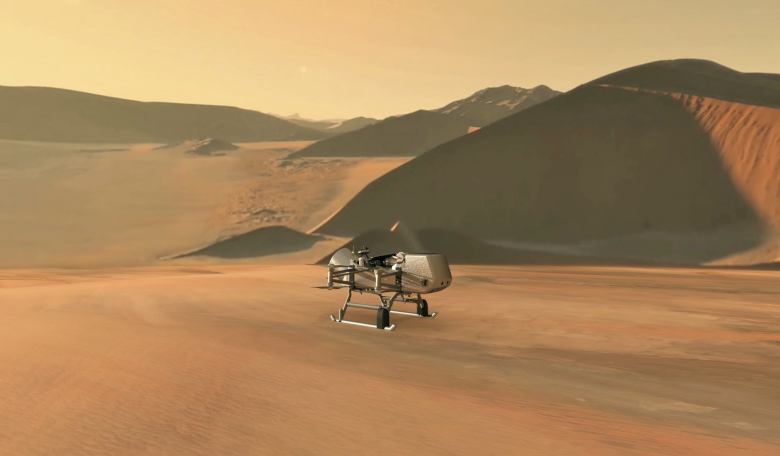Small flying drones are taking over the skies on Earth, and soon they could be a regular feature on our nearest planetary neighbours too. NASA has already said it will send a small Marscopter to the Red Planet with its Mars 2020 mission and now the agency has said it will send a quadcopter to search for the building blocks of life on Saturn’s moon Titan.
Titan is no ordinary moon; not only is this exceptional world big enough to be a planet in its own right, it has a hydrologic system whereby heavy methane storms cause rain to pour down on the surface. But instead of a water cycle like on Earth, when it precipitates on Titan, it creates vast rivers, lakes and seas made of hydrocarbons – a spectacular sight for certain, but perhaps somewhere you wouldn’t want to go for a swim.
Also like Earth, Titan is encased by a thick nitrogen atmosphere, but unlike our temperate planet, given the enormous distance separating it from the Sun – some 1,500 million kilometres – Titan’s surface temperatures are an icy 180ºC below zero. However despite the frigid conditions, the polar regions do experience summer to some degree, sufficient enough to raise the temperature slightly and provide the energy needed to kick start the stormy episodes.
Because of the similarities, Titan is said to be the best analog of how an Earth would have appeared in its early history and as such it could provide clues as to how life may have arisen on our planet. There is little wonder then why scientists have been vying for the chance to return to this exceptional world ever since Pionneer 11 first clapped eyes on it back in 1979 and since the Cassini and Huygens mission only added further intrigue as to the answers this replica of a young Earth could provide.
All could be revealed within the next decade, as NASA will not merely land on Titans’s surface like Huygens did, but it will hover over it in a large drone-like craft that has eight rotors. Called Dragonfly, this newly announced mission has been given a launch date of 2026, with an anticipated arrival date of 2034 at this extraordinary world.
The flying laboratories design means the vehicle will be able to soar through Titan’s thick atmosphere and take its entire science payload to new locations or make repeated stops at places of interest in times that a traditional rover could only hope to achieve; indeed, Dragonfly’s goal is to fly more than 175 kilometres (108 miles) during its 2.7-year baseline mission – nearly double the distance travelled to date by all the Mars rovers combined.
“Visiting this mysterious ocean world could revolutionise what we know about life in the universe,” said NASA Administrator Jim Bridenstine at a press conference yesterday. “This cutting-edge mission would have been unthinkable even just a few years ago, but we’re now ready for Dragonfly’s amazing flight.”
First on its list of targets to study are the equatorial “Shangri-La” dune fields. These are terrestrially similar to the linear dunes in Namibia in southern Africa and Dragonfly will “leapfrog” up to 8 kilometres (5 miles) at a time up the slopes of the escarpment, while stopping to take samples as it heads towards Selk impact crater.
Dragonfly’s instruments will search for chemical evidence of past or extant life and in doing so could shed light on how far prebiotic chemistry may have progressed from an earlier evolutionary period. Nothing is off the books however and the crafts instruments will also study the moon’s atmospheric and surface properties along with its subsurface ocean and liquid reservoirs.
“Titan is unlike any other place in the solar system, and Dragonfly is like no other mission,” said Thomas Zurbuchen, NASA’s associate administrator for Science at the agency’s Headquarters in Washington. “It’s remarkable to think of this rotorcraft flying miles and miles across the organic sand dunes of Saturn’s largest moon, exploring the processes that shape this extraordinary environment. Dragonfly will visit a world filled with a wide variety of organic compounds, which are the building blocks of life and could teach us about the origin of life itself.”











